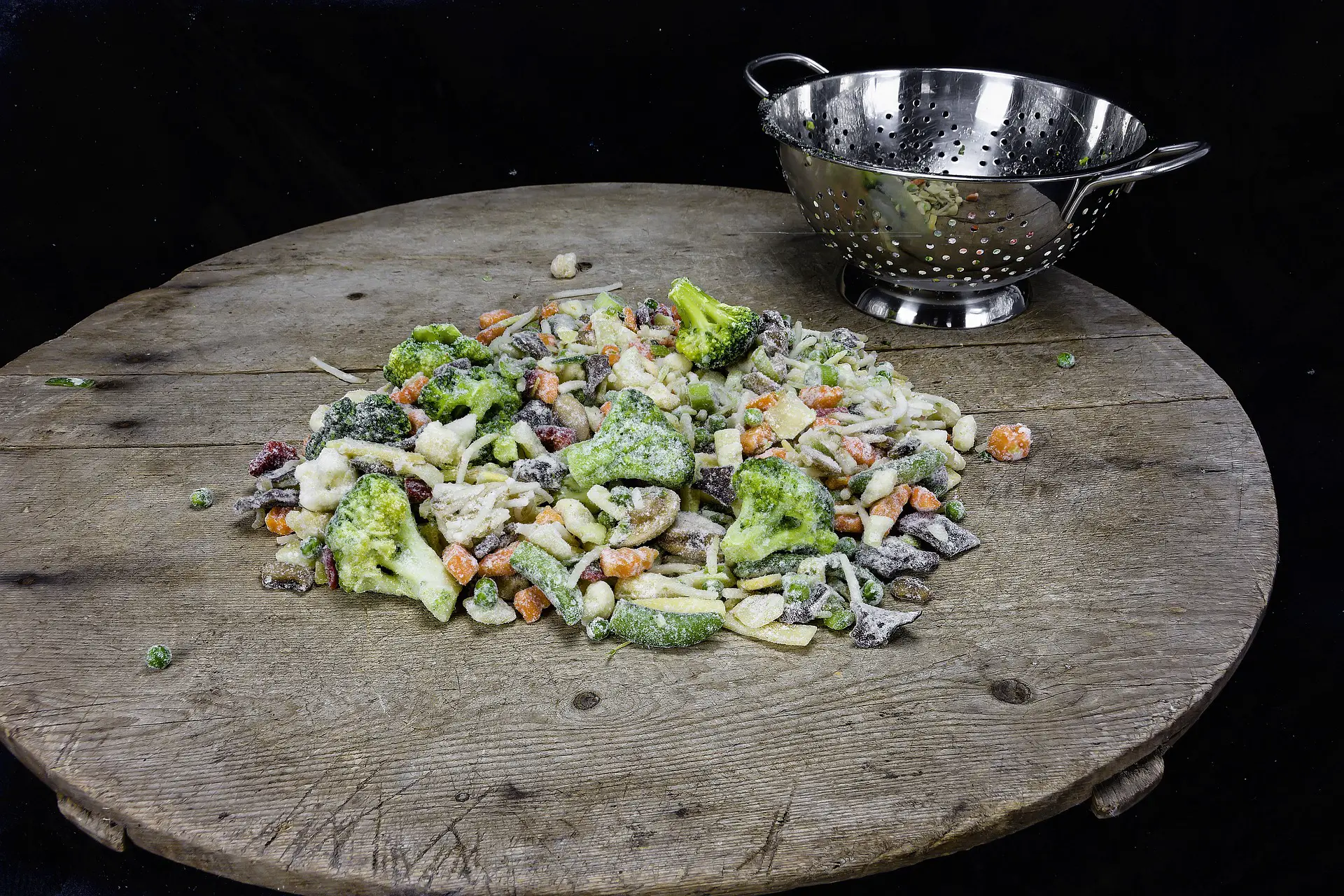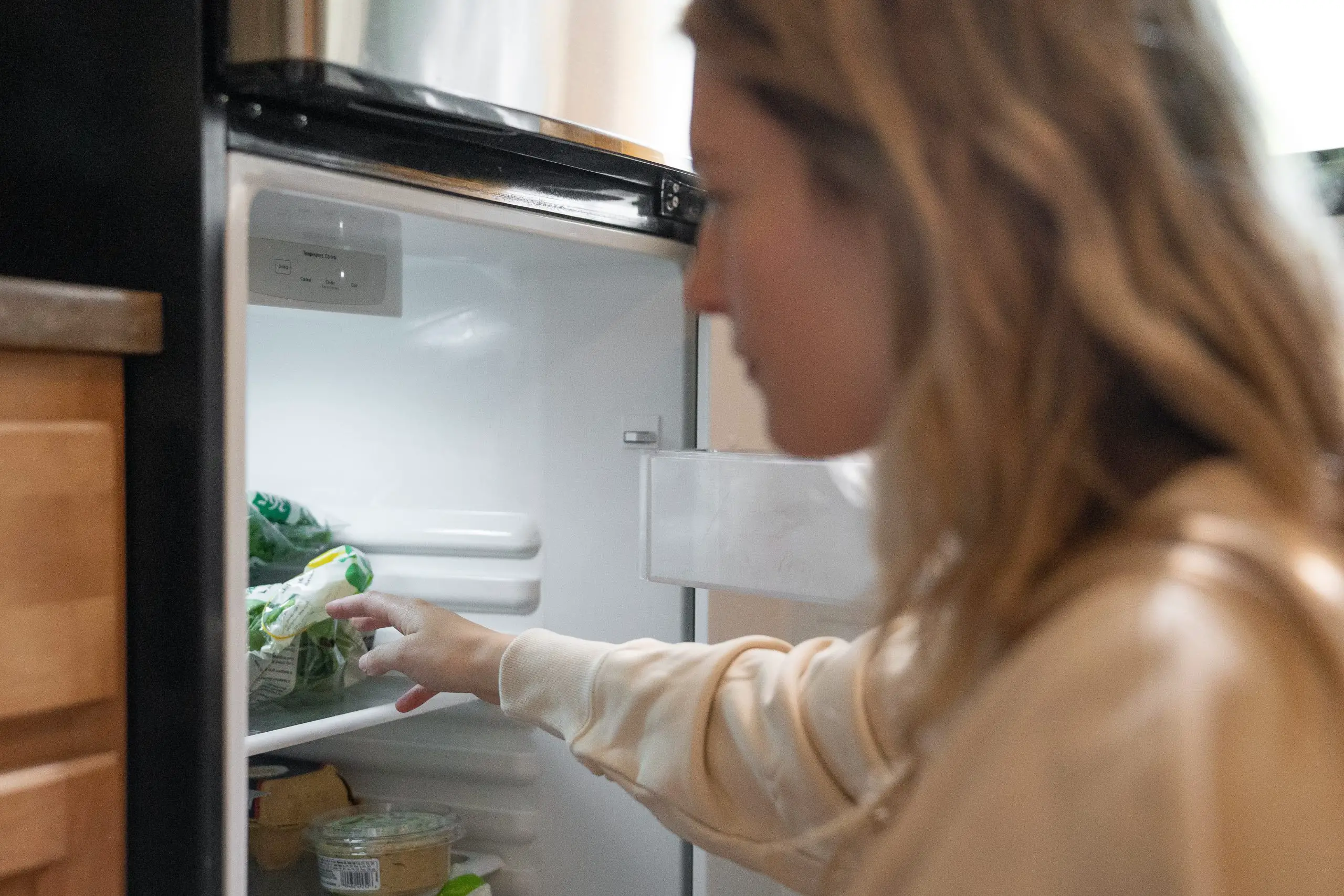Opening your refrigerator in the morning to discover that the bottle of milk you put in there yesterday is now frozen solid can be pretty unsettling. If you look at your beverage bottles, veggies, fruit, and other products, it is simple to observe that they also appear frozen. Your initial reaction might be that the milk has expired. This may increase your grocery bill, but it is also a surefire sign of a problem with your refrigerator. Here are five potential causes of things becoming frozen in your appliance.

Why does my Refrigerator Freeze Food?
1. Your Thermostat is too High
The thermostat might be easily moved and inadvertently raised when putting groceries in or taking things out of the refrigerator. If you thought the refrigerator wasn’t quite cool enough, you might have purposefully raised the temperature. The thermostat adjustment knob on most refrigerators has a mark. However, this fades over time. As a result, precisely monitoring the indicated temperature is no longer possible. Therefore, you might have accidentally set the thermostat far higher than you planned, resulting in everything becoming frozen and more energy use and higher expenses.
2. Your Gasket is Faulty
The gasket is a lining for the refrigerator door, sealing the compartment and limiting heat transfer between the refrigerator’s interior and the surrounding space. Your refrigerator will run continuously to compensate for a damaged gasket and leaking gas, which will start to freeze everything within. Placing a piece of paper in the door and attempting to remove it without opening it is a simple test to see whether you have a faulty gasket. You need to replace the gasket if the paper is easily removable or won’t stay in place.
3. You have Dirty Coils
Along with the evaporator coils inside the appliance, your refrigerator has condenser and heat exchanger coils installed outside. These coils enable the refrigerant fluid to carry out its heat exchange function. The refrigerator must work harder to maintain the ideal temperature when these coils are covered in dust or other types of filth. The impacts of winter inside your refrigerator and overcooling might, unfortunately, sometimes result from this. You may find cleaning instructions for the coils in your owner’s manual. It is a good idea to clean the coils frequently to prevent difficulties in the future.
4. You Possess a Defective Thermostat
Thermostats are made to activate cooling when it’s required. As soon as the desired temperature is reached, it should automatically shut off in the refrigerator. To keep the temperature steady and as desired, this is necessary. Your thermostat may malfunction and fail to shut off, leaving it running continuously.
5. Damper Issues
You might be familiar with a damper if you own a refrigerator or freezer. Essentially, this is the assembly required to control the rates at which chilled air from the freezer enters the refrigerator. A broken damper may result in more air flowing into the refrigerator compartment, gradually lowering the temperature. You’ll need the assistance of a skilled appliance repair professional if you think you might have damper issues.
What to do if your Refrigerator is Freezing Everything?
An essential component of your refrigerator door is the gasket; if it is damaged or cracked, your refrigerator won’t maintain food‘s frozen state. Any cold air that has been kept in the compartment can escape once the seal is broken and enter the warmer environment, leaving a cold storage box with a propensity to freeze its contents.
You can utilize a pretty easy remedy if you can’t seal your refrigerator door properly. Simply layer a fresh gasket over your old one, ensuring it is well seated within the door’s grooves. To help the new gasket grow accustomed to the area, open and shut the refrigerator door a few times.
The easiest approach to guarantee that your food is safe is to check your thermometer regularly. Still, in case your refrigerator or freezer becomes overly warm or cold, there are steps you can take to make sure everything is operating as it should.
Shut the door! While you’re cooking or unpacking groceries, it’s simple to leave the door open. However, it would help if you only did this when required.
Spread your food out. Keep your food spaced out to allow for proper air circulation in the refrigerator and freezer, even if it may seem foolish. A fully stocked fridge is more likely to be warmer than one that isn’t.
Refresh the coils. Your refrigerator may occasionally require care and attention, much like other appliances. To prevent refrigerator repairs, clean the coils at least once a year.
What is the Ideal Refrigerator Temperature?
The ideal freezer and refrigerator temperatures are 0°F (-18°C) and at or below 40°F (4°C), respectively. Despite having all the bells and whistles, some refrigerators and freezers may not include a built-in thermometer. Thankfully, appliance thermometers are typically affordable and available at most kitchen appliance retailers and on Amazon.
Finding the ideal refrigerator temperature ensures that your fruit and leftovers last as long as possible. It’s also one of the simplest methods to avoid becoming sick from eating milk, eggs, and dairy that has gone bad or expired. While correctly freezing is an excellent way to store bulk things like meat, the FDA warns that the longer your food is frozen, the more it will lose its “tenderness, flavour, fragrance, juiciness, and colour.” Here is our overview of foods that have freezer burn.
Get inventive if you’re concerned that your leftovers will spoil before you can use them. Leftover meat may be put into a clear soup or combined with eggs to make a flaky quiche or frittata, as our cooking editor Peggy Woodward explains. Put an egg on top of whatever cooked vegetables you have a small amount of remaining, and eat the dish for dinner. Rice made from leftover grains is delectable. Fruits and chopped veggies can be added to a fruit salad or stir-fried. Try these leftover chicken recipes as well.
Using the Generalized Reduced Gradient (GRG) method, the cycle is optimized for maximum second-law efficiency at each refrigeration temperature. It has been discovered that this cycle can achieve refrigeration temperatures as low as 205 K. When refrigeration temperature drops, first and second-law efficiencies typically decline. The first and second law efficiencies rise slightly as the refrigeration temperature drops from 265K to 245K for a recirculating type solar thermal system with a source temperature of 360K. Then they fall with the refrigeration temperature, giving a maximum second-law efficiency of 63.7% at 245K.
How to Avoid Food in the Refrigerator Becoming Frozen?
You may take measures to fix the issue if your refrigerator starts to freeze.
Reset the Temperature on your Refrigerator
Your refrigerator’s temperature dial should indicate what the ideal temperature is. For more information, refer to the owner’s manual if you’re unsure about the ideal temperature.
Temperature settings for the KitchenAid refrigerator.
Transport your Items
You might need to add extra food to the refrigerator or spread your foods equally, so they don’t obstruct the air vents.
Check the Door Seals on your Refrigerator
It’s crucial to replace your refrigerator’s door seals when they look worn. Not only will you save your meals from freezing, but you’ll also conserve electricity.
How to Choose Proper Refrigerator for Storing and Freezing Food Items?
Select the Layout and Design of your Refrigerator.
With the ideal refrigerator design and configuration for your family, you can arrange and store your preferred fresh and frozen foods just the way you like them. To discover the perfect fit, check out more about French door refrigerators with a pantry-style design, modern side-by-side refrigerators, traditional top or bottom-freezer refrigerators, or specialist under-counter refrigerator types.
Think About Storage Possibilities and Fridge Capacity
When comparing the overall size of refrigerators, use capacity is expressed in cubic feet (cu. ft.). When shopping, keep these things in mind:
Your family’s size and the number of groceries you bring home will help you calculate how many cubic feet you’ll need.
Favorite snacks can be kept in outside drawers or storage areas on the inside doors for easy access by anyone who wants them.
Certain designs, such as French doors and side-by-side, typically include specialty storage options, like sliding shelves and broad trays, whether you need to store particularly tall goods or huge platters.
Whether you require a refrigerator with a regular capacity of about 20 cubic feet or one with a high capacity of up to about 30 cubic feet, if you have a small household or little room, small space refrigerators typically have capacities between 11 and 18 cubic feet. Mini-fridge sizes typically range from 4 to 5 cubic feet if interested.
Our large selection of chest and upright freezers, which frequently convert to refrigerators when your storage needs change, also come with sliding baskets on three storage levels to keep food visible and simple to access if you frequently need space for bulk freezer purchases or extra fresh food storage space.
Conclusion
Often when you are putting food in your refrigerator, it will freeze. But there are a few things that you can do to help fix this problem. The first thing you should do is check the settings on your refrigerator. You should also check to see if the temperature control is working properly. You can also clean the condenser coils and the damper.
Ensure that your refrigerator is stocked with plenty of food. This will allow it to run efficiently and will reduce your utility bills. Also, make sure that the temperature settings on the refrigerator are correct.

